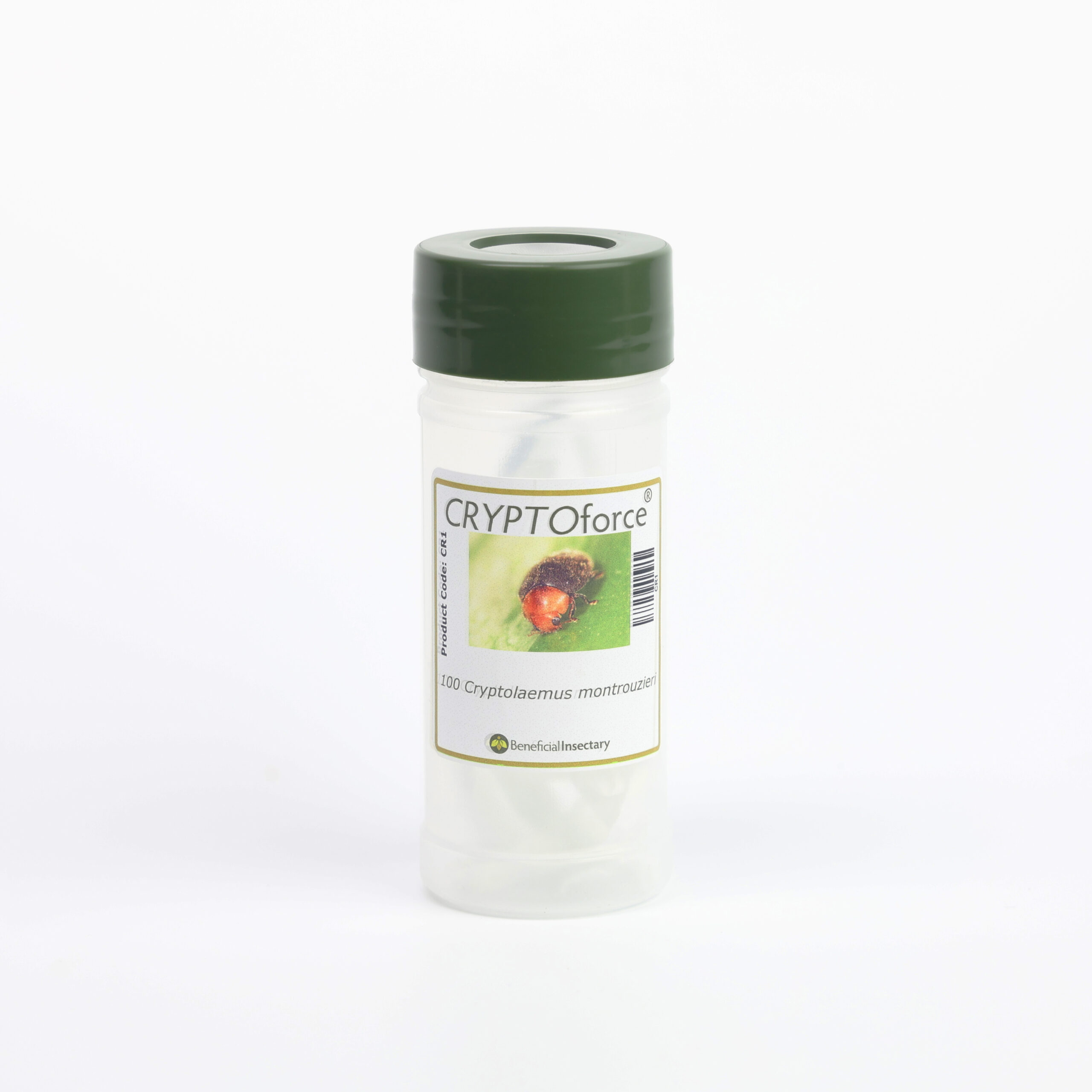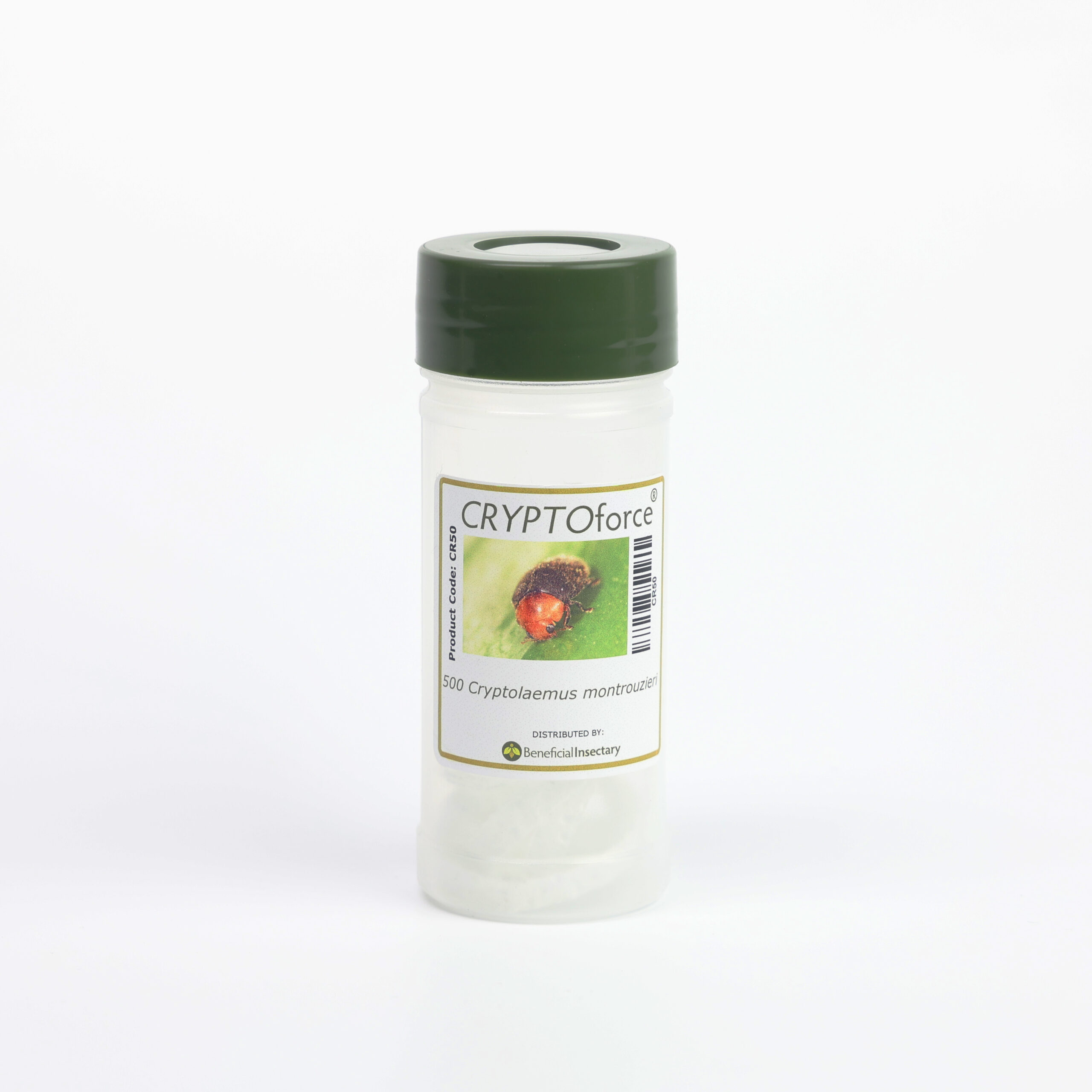CRYPTOforce™
CRYPTOforce™
CRYPTOforce™ are predatory beetles, also known as “Mealybug Destroyers”
Cryptolaemus montrouzieri
Mainly used for mealybug control, but will also feed on certain species of scale insects
Citrus Mealybug (Planococcus citri)
Comstock Mealybug (Pseudococcus comstocki)
Obscure Mealybug (Pseudococcus obscurus)
Solenopsis Mealybug (Phenacoccus solenopsis)
Mexican Mealybug (Phenacoccus gossypii)
Long-Tailed Mealybug (Pseudococcus longispinus)
Crawling and Immature Stages of Some Scale Insects
Fruit Crops
Ornamental Crops
Vegetable Crops
We have seen the successful implementation of this species in just about every conceivable situation – most with equal success.


Females can lay up to 400 eggs in “Hot Spots.” Adults and older larvae feed more than in earlier stages. Young larvae prefer eggs and early instar mealybugs, while older larvae and adults feed on all stages of the mealybug. They can consume 30 to 70 prey per day.
Do not store Cryptolaemus adults for more than 18 hours.
Hold at a moderately humid 50-55ºF until ready to release.
Do not release in the heat of the day. Mist the foliage of the plants to be treated just before treatment. To release, open the container in the crop area and gently tap out the beetles directly onto the foliage of the infested plants, or evenly throughout the crop if the infestation is widespread. Be sure to let the beetles warm up first. If possible, release the beetles next to or on the “cottony egg masses,” if present. Use the cap of the container to control the dispersal. Concentrate the bulk of the predators at release points on or near the most heavily infested plants.
Please note the following:
If you wear white or lightly colored clothing during the release, the beetles may be attracted to you. Experimentally, to assist the beetles in locating their prey, place white 3 “x5” cards close to a mealybug hot spot. Also, experimentally, if you are using this predator against the long-tailed mealybug or other species which does not lay its eggs in cottony masses, place pea-size amounts of synthetic batting (available at craft stores) near mealybug colonies. This may facilitate and encourage egg laying resulting in a higher fecundity.
Do not substitute batting with cotton balls; they may contain pesticide residues. Supplying these beetles with certain crops (flowering, pollen-producing plants) may also increase their egg laying activity at or near the release site.
The beetles are conspicuous, so spotting them in the crop with diligent scouting is possible. Also, look for reducing pest numbers and “exploded” mealybug egg masses.
CRYPTOforce™ needs to lay its eggs in the cottony egg masses of its prey.
Since long-tailed mealybugs don’t have the cottony egg masses but rather lay individual eggs that almost instantly hatch, the establishment of Cryptolaemus will be difficult or impossible.
CRYPTOforce™ will eat immature long-tailed mealybugs; they can’t reproduce on them.
Live-Product: Beneficial Insectary strives to guarantee the live delivery of the freshest organisms to our customers. We offer replacements or credits for any compromised shipments to our customers that report any issues or concerns within 24 hours. These issues or concerns must be relayed before releasing any organisms that are suspected of having viability issues. Please do not discard the product. You may be requested to return the shipment for further analysis.
Establishment of BCAs in Crop Settings: Many variables can negatively or positively impact BCA and pest populations in various crops we work with (pesticide applications, watering practices, improper storage methods, cultural/physical/mechanical controls, etc.). Some beneficial organisms require a steady pest presence as a food source to build their population. Others may require alternate food sources, such as pollen or nectar as an example. While other BCAs have specific photoperiod requirements for success. Due to these variables, we cannot guarantee the long- or short-term establishment of the BCAs we sell after the release of the organism(s). We will not offer refunds, discounts, or other credits on products that have already been released. Please adhere to our “Live-Product” disclosure.
PRODUCT RELEASE METHOD
PRODUCT SPECIFICATIONS
PRODUCT | PACKAGE SIZE Filler/Carrier | LIFE STAGES | PRODUCT CODE |
|---|---|---|---|
CRYPTOforce™ C – 100 | 4oz Bottle w/ Filter Paper | Adults | CR1 |
CRYPTOforce™ C – 250 | 4oz Bottle w/ Filter Paper | Adults | CR25 |
CRYPTOforce™ C – 500 | 4oz Bottle w/ Filter Paper | Adults | CR50 |
RELEASE RATES
CLASSIFICATION | RELEASE INFORMATION |
|---|---|
Light Infestation | 2 to 4 per 10 sq. ft, repeat as needed |
Heavy Infestation | 10 to 12 per 10 sq. ft., repeat as needed |
Orchards | 1,000 to 2,000 per acre |
Life Cycle
EGG STAGE
- Adult female beetles lay their eggs in the cottony egg-masses produced by the pests
LARVAE
- The eggs hatch into white, shaggy-coated larvae
- To the inexperienced eye the larvae can look like mealybugs
- Fierce Predators
- Growing up to 1cm. long and consuming 250 or so small mealybugs and their eggs
ADULT
- Life-Span: 1 Month
- Fierce Predators
- Black-brown wing-cases, and an orangish-brown head, thorax and, abdomen
- Can reach a length of up to 4mm
